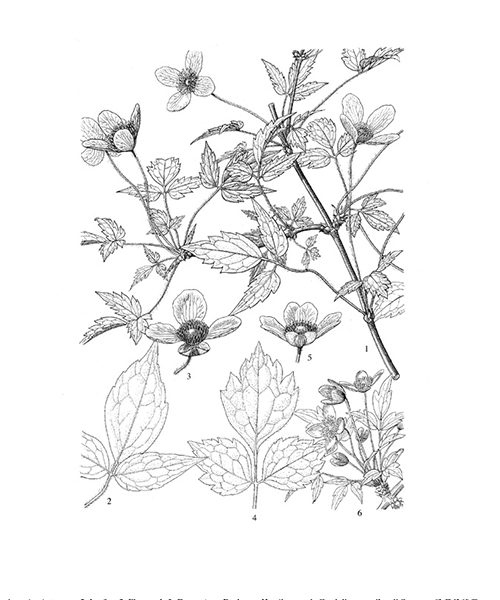Clematis montana
Clematis montana
1. The products in our compound library are selected from thousands of unique natural products; 2. It has the characteristics of diverse structure, diverse sources and wide coverage of activities; 3. Provide information on the activity of products from major journals, patents and research reports around the world, providing theoretical direction and research basis for further research and screening; 4. Free combination according to the type, source, target and disease of natural product; 5. The compound powder is placed in a covered tube and then discharged into a 10 x 10 cryostat; 6. Transport in ice pack or dry ice pack. Please store it at -20 °C as soon as possible after receiving the product, and use it as soon as possible after opening.

Natural products/compounds from Clematis montana
- Cat.No. Product Name CAS Number COA
-
BCN5159
alpha-Hederin27013-91-8
Instructions

Conformational study reveals amino acid residues essential for hemagglutinating and anti-proliferative activities of Clematis montana lectin.[Pubmed: 25239139]
Clematis montana lectin (CML), a novel mannose-binding lectin purified from C. montana Buch.-Ham stem (Ranunculaceae), has been proved to have hemagglutinating activity in rabbit erythrocytes and apoptosis-inducing activity in tumor cells. However, the biochemical properties of CML have not revealed and its structural information still needs to be elucidated. In this study, it was found that CML possessed quite good thermostability and alkaline resistance, and its hemagglutinating activity was bivalent metal cation dependent. In addition, hemagglutination test and fluorescence spectroscopy proved that GuHCl, urea, and sodium dodecyl sulfate could change the conformation of CML and further caused the loss of hemagglutination activity. Moreover, the changes of fluorescence spectrum indicated that the tryptophan (Trp) microenvironment conversion might be related to the conformation and bioactivities of CML. In addition, it was also found that Trp residues, arginine (Arg) residues, and sulfhydryl were important for the hemagglutinating activity of CML, but only Trp was proved to be crucial for the CML conformation. Furthermore, the Trp, Arg, and sulfhydryl-modified CML exhibited 97.17%, 76.99%, and 49.64% loss of its anti-proliferative activity, respectively, which was consistent with the alterations of its hemagglutinating activity. Given these findings, Trp residues on the surface of CML are essential for the active center to form substrate-accessible conformation and suitable environment for carbohydrate binding.
Clematis montana lectin, a novel mannose-binding lectin from traditional Chinese medicine with antiviral and apoptosis-inducing activities.[Pubmed: 19577602]
A novel mannose-binding lectin (designated CML) was isolated from Clematis montana Buch.-Ham stem (Ranunculaceae) using ion exchange and gel filtration chromatographies on DEAE-Sepharose and Sephacryl S-100. The purified C. montana lectin was a homodimer of 11,968.9 Da subunits as determined by gel filtration and MS. The hemagglutinating activity of CML was inhibited by branched oligomannosides. The N-terminal 15-amino acid sequence of CML, DNVKYSGQVKNTGSA, has not been reported for other lectins. Also, the peptide mass fingerprinting assay confirmed that there is no match result of similar plant lectins for CML, indicating CML may be a novel plant lectin. CML showed marked antiviral activity against various viruses in cell culture. Subsequently, CML was also found to exhibit remarkable inhibitory effect on L929, HeLa, MCF7 and HepG2 cells. Furthermore, CML specially induced L929 cell apoptosis in dose-dependent manner as evidenced by MTT, fluorescent microscopy, LDH activity-based cytotoxicity assays and DNA ladder. Moreover, due to both caspase inhibitors and Western blot analyses, caspase was also found to play the important role in the potential apoptotic mechanism of CML. When the carbohydrate-binding site was fully inhibited by sugars, cytotoxicity was abruptly decreased and apoptotic phenomenon in L929 cells was not observed, suggesting a significant correlation between mannose-binding-specific activity and the antineoplastic mechanism.
An oleanolic acid based bisglycoside from Clematis montana roots.[Pubmed: 7764156]
Clemontanoside F, a new triterpenic bisglycoside from the roots of Clematis montana, has been characterized as 3-O-beta-D-glucopyranosyl-28-O-beta-D-galactopyranosyl(1-->6)-[alpha-L-r hamnopyranosyl (1-->)]-beta-D-glucopyranosyl-3beta-hydroxy-olean-12-en-28- oate.
Clemontanoside-C, a saponin from Clematis montana.[Pubmed: 7763801]
Clemontanoside-C, a new hederagenin-based saponin isolated from the stems of Clematis montana, was identified by chemical and spectroscopic methods as hederagenin-3-O-alpha-L-arabinopyranosyl (1-3)-alpha-L-rhamnopyranosyl (1-2)-alpha-L-arabinopyranoside.


